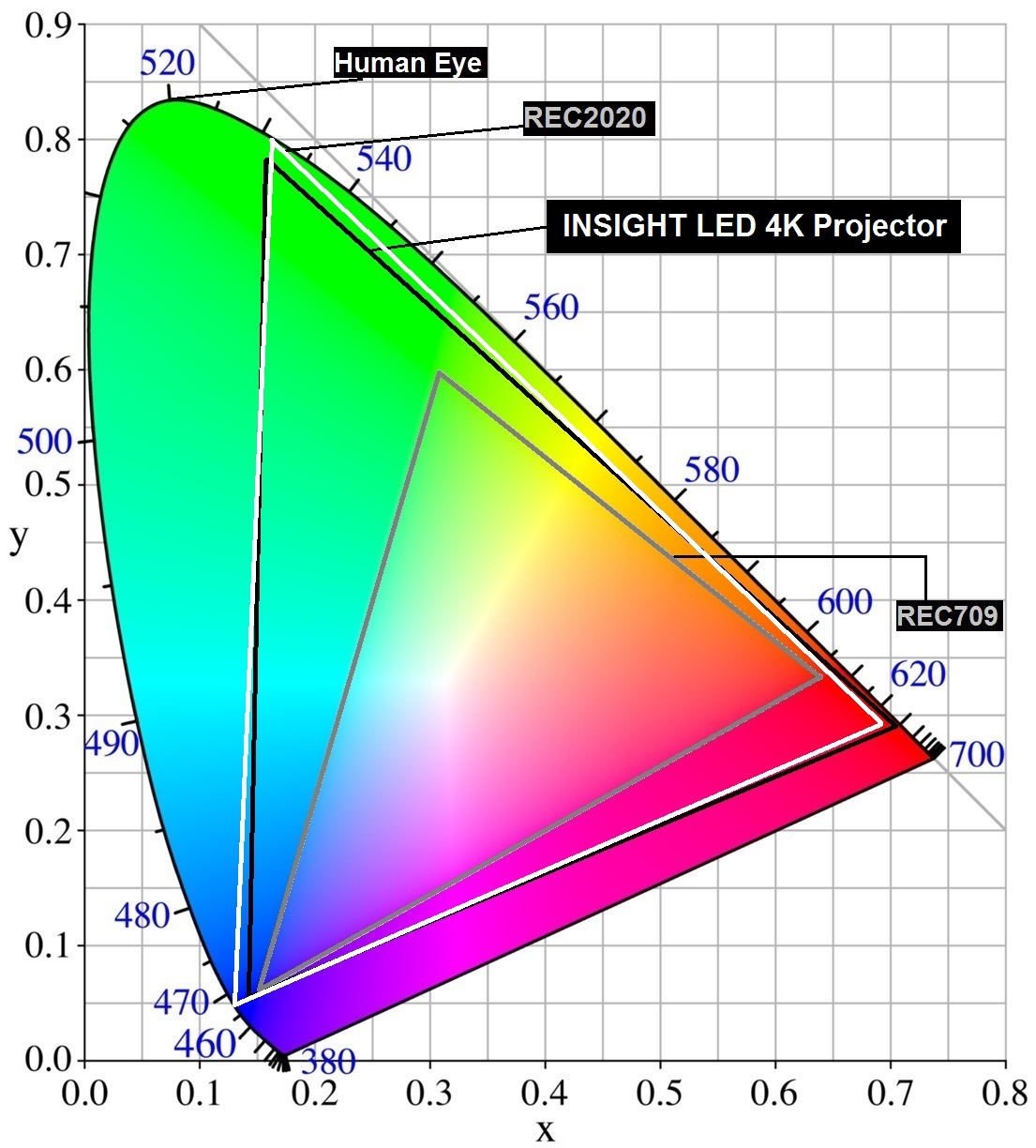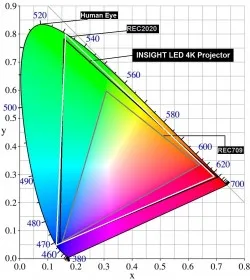Insight Media’s Chris Chinnock was asked by Digital Projection to give presentations about how to create great home theater images and to highlight DP’s two Insight projectors. On display were the Insight 4K Laser projector and the Insight 4K Dual LED projector.
Chinnock started the presentation by describing four key factors in producing a great image in a home theater. These included:
- Venue Dynamic Range – this is more than just the contrast and brightness of the projector, one must consider screen materials and gain profiles as well. Most important is the ambient lighting condition. He referenced InfoComm’s Projection Image System Contrast Ratio (PISCR) document as a great way to get some guidance for developing a venue or system level contrast spec.
- Color management – with UHD and wide color gamut content, you need a 10-bit pipeline. And this content will play to its full potential on projectors and displays that can go beyond the current rec. 709 color gamut. But integrators should also offer a reference setting that included a calibrated color-accurate setting – even if the home owner chooses not to watch a calibrated image.
- Image Processing – resolution scaling, color processing, frame rate conversion and motion compensation can happen in the set top box, AV receiver, Blu-ray player or the projector/TV. Integrators should evaluate which component does the best job of these functions and disable other processing. Processing on top of processing can degrade the image.
- Room Geometry – Close viewing means integrators should suggest a 4K resolution display to avoid seeing pixels, but viewing a 4K from further back can be beneficial too – but it is content dependent. The human eye is very sensitive to edge detection – more so than visual acuity, so images with a lot of texture, and edges will appear more crisp from the back of the room with a 4K projector vs. a 1080p projector.
The Insight 4K Laser projector from Digital Projection is a laser phosphor model with 12,000 peak lumens, but this can be turned down continuously to 4000 lumens. That’s great flexibility to allow lights up viewing or dark room viewing. And since it is a solid state source, lifetime is rated at 20,000 hours to 50% of original brightness. That might save as much as $20K in lamp replacement charges, so installers and home owner have a choice between paying a little more up front for the laser projector or paying “as-you-go” for a lamp-based projector. Demonstration content focused on the bright image with the lights up and the crisp, sharp details visible in the 4K image – even from the back of the room.
Chinnock next turned to the Insight 4K Dual LED projector where he noted that the projector comes very close to achieving the full UHD and Blu-ray rec 2020 color gamut specification. Displaying wide color gamut content natively with this large color gamut allows home owners to see colors they have never seen before on lamp-based projectors and colors that are more richly saturated. Chinnock noted that more saturated colors can be produced on displays with smaller color gamuts, but doing so will distort the images – sometimes making them gaudy and unwatchable. Having a native wide color gamut capability allows color accurate and highly saturated colors simultaneously – a huge benefit. The only other projectors capable of achieving a color gamut like this are RGB laser projectors at 5 to 10 times the cost.

Another benefit of richly saturated colors is the HK effect. This effect is based on the observation that more saturated colors appear brighter than less saturated one. This effect increases the perceived brightness of the projector by about 25%. As a result, DP specs the LED projector at 3000 lumens including the HK effect. That means a light meter will measure only about 2400 lumens, but the projector will appear as bright as a 3000 lumen lamp based projector with a less saturated color capability.
The lights were then dimmed and content on the LED projector was shown that highlighted the vivid colors in nature along with some content produced by the University of Stuttgart. This content renders the same scene in a 2020 gamut, P3 cinema gamut and 709 HDTV gamut. It clearly shows the reds and blues becoming less saturated as the color space shrinks from 2020 to P3 to 709.
Finally, Chinnock helped Prima Cinema debut their new 4K server showing a clip from the Star Trek series. This was the theatrical release shown in 4:2:2 and with the P3 color gamut. The reds and yellows were incredibly saturated, yet the flesh tones remained correct. This was the highlight for many of the attendees.

Chinnock concluded by noting that DP has a robust pre- and post-sales support service to help design and configure the video solution. If an installer sells an Insight model, DP will send a technician to the home owner’s house to help with set up so the owner and integrator are happy. And, DP has some good margins, so that should make all quite happy.
The Insight Laser projector is available now for $120K while the LED is available for $150K. – CC

